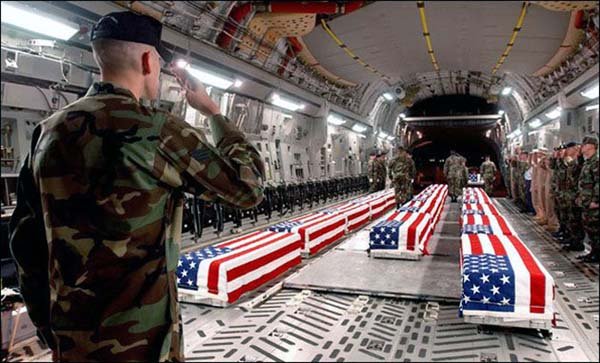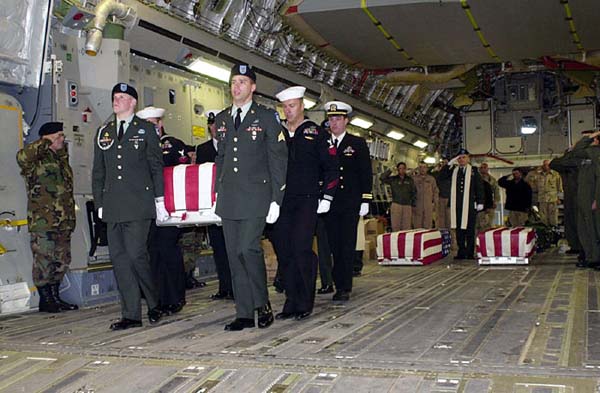Return of the Fallen
- Page 1
To Cover Up Our Losses The Media Was Forbidden
To Show Flag Draped Coffins. A Lawsuit Released The Images.
As I was writing an account of our American Casualties
I noticed I was unable to find any photos of flag draped Coffins, particularly
in incoming military aircraft. I found out the reason. The Government
imposed a ban on media Coverage of returning casualties in an effort to
cover up our losses . There were no photos until a lawsuit By the National
Security Archive challenged the Governments policy. The FREEDOM OF INFORMATION
ACT case was Filed in Federal District Court for the District of Columbia.
The court ruled the images were to be released to the public. Many called
the original prevention of media coverage the "Bush Cheney"
act. Hundreds of photos were released.
I respectfully show a few of these.

RETURN OF THE FALLEN - WIKIPEDIA
PENTAGON RELEASES HUNDREDS MORE WAR CASUALTY HOMECOMING IMAGES FREEDOM OF INFORMATION ACT FORCES OPENING OF 360 NEW PHOTOS CONFIRMS WAR CASUALTY HONOR CEREMONY IMAGES BELONG IN PUBLIC
Washington, D.C., April 28, 2005 - In response to Freedom of Information Act requests and a lawsuit, the Pentagon this week released hundreds of previously secret images of casualties returning to honor guard ceremonies from the Afghanistan and Iraq wars and other conflicts, confirming that images of their flag-draped coffins are rightfully part of the public record, despite its earlier insistence that such images should be kept secret.
One year after the start of a series of Freedom of Information Act requests filed by University of Delaware Professor Ralph Begleiter with the assistance of the National Security Archive, and six months after a lawsuit charging the Pentagon with failing to comply with the Act, the Pentagon made public more than 700 images of the return of American casualties to Dover Air Force Base and other U.S. military facilities, where the fallen troops received honor guard ceremonies. The Pentagon officially refers to the photos as "images of the memorial and arrival ceremonies for deceased military personnel arriving from overseas." Many of the images show evidence of censorship, which the Pentagon says is intended to conceal identifiable personal information of military personnel involved in the homecoming ceremonies.

RETURN OF THE FALLEN
Begleiter's lawsuit is supported by the National Security Archive and the Washington, D.C. office of the law firm Jenner & Block. "This is an important victory for the American people, for the families of troops killed in the line of duty during wartime, and for the honor of those who have made the ultimate sacrifice for their country," said Begleiter, a former CNN Washington correspondent who teaches journalism and political science at the University of Delaware. "This significant decision by the Pentagon should make it difficult, if not impossible, for any U.S. government in the future to hide the human cost of war from the American people."
The Pentagon's decision preempted a court ruling in the lawsuit by U.S. District Judge Emmet G. Sullivan. "We are gratified that these important public records were released without the need for further court action," said Daniel Mach of Jenner & Block. The Pentagon ban on media coverage of returning war casualties was initiated in January 1991 by then Secretary of Defense Dick Cheney during the administration of President George H. W. Bush, just weeks before the start of the Gulf War against Iraq.

RETURN OF THE FALLEN
"I have never considered the release of images as a political issue," said Begleiter, noting that both Republican and Democratic administrations imposed the image ban. "But, seeing the cost of war, like any highly-charged political issue, can have strong political consequences."
Begleiter's Freedom of Information Act requests, and the lawsuit, asked for release of both still and video images. The Pentagon's "final response" in the case includes no video images of the honor ceremonies for returning war casualties. "I'm surprised at this," said Begleiter, "because the U.S. military uses video and film technology extensively in its public relations efforts."